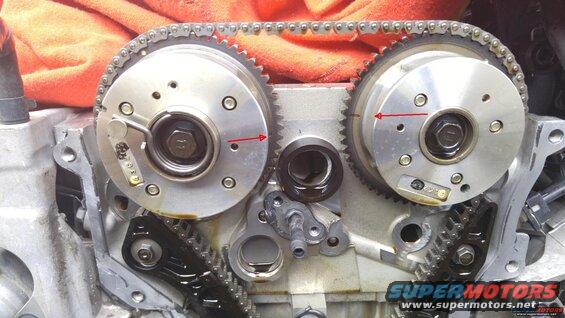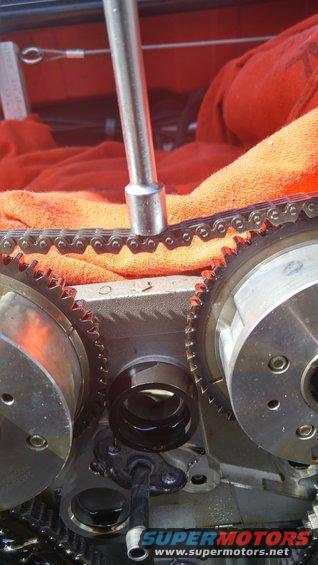So, the guys who say, “I’d rather have a chain than a belt” must love this engine, right? Certainly, Audi engineers thought a chain was better than a belt…
You are using an out of date browser. It may not display this or other websites correctly.
You should upgrade or use an alternative browser.
You should upgrade or use an alternative browser.
Timing chain change interval?
- Thread starter borgward
- Start date
190k+ on my Mazda 2.5L on the original timing chain. Sometimes I wonder how much stretch it has. I expect it to last a good while longer. Haven’t heard of anyone having replace a timing chain before with exception of some notorious offenders known for bad chains.
- Joined
- Jun 8, 2022
- Messages
- 5,587
Is there a way to actually check a timing chain? Any that I had, by the time you get the cover off to see how far the tensioner moved you might as well change it at that point?But I would be checking at about 100,000.
I ran a olds 3.1, a Jeep 4.7 and a Ford 4.6 all past 200K with no indication of any pending timing chain issue.
My Xterra Timing chain "failed" at around 240K?. It was a known defect - Dana stamped the links and they used their die's too long and caused burrs. The burrs caused the chain to wear out the guides, and you knew because it would start to whine off idle. The redesign was supposed to eliminate the burrs, and they added something to the links to help them hold lubrication better as well. Its supposed to be lifetime. My Frontier has the same engine with the redesigned chain - we will see how long it lasts. The Xterra got the new OEM chain - so it now has 150K ish on it also?
As always, a chain will last longest with a true 30 viscosity oil, and will suffer with a high particulate load.
Many of today's chains now use coated pins, to extend chain life. In particular, the better manufacturers.
Many of today's chains now use coated pins, to extend chain life. In particular, the better manufacturers.
There is on the Mercedes, and some of the engines with which I’m familiar. You can see the chain stretch because the timing marks between the two cylinder banks don’t lineup.Is there a way to actually check a timing chain? Any that I had, by the time you get the cover off to see how far the tensioner moved you might as well change it at that point?
I ran a olds 3.1, a Jeep 4.7 and a Ford 4.6 all past 200K with no indication of any pending timing chain issue.
My Xterra Timing chain "failed" at around 240K?. It was a known defect - Dana stamped the links and they used their die's too long and caused burrs. The burrs caused the chain to wear out the guides, and you knew because it would start to whine off idle. The redesign was supposed to eliminate the burrs, and they added something to the links to help them hold lubrication better as well. Its supposed to be lifetime. My Frontier has the same engine with the redesigned chain - we will see how long it lasts. The Xterra got the new OEM chain - so it now has 150K ish on it also?
But you’re right on a small block Ford or a small block Chevy there’s really no way to check. I just hope it doesn’t jump time…but if they get noisy, it’s time to throw in a new one.
- Joined
- Jun 22, 2022
- Messages
- 1,011
Some engines will have a rattle at startup but Audi says it's OK. I don't think chains have been an issue on these engines if they have had regular oil changes.So, the guys who say, “I’d rather have a chain than a belt” must love this engine, right? Certainly, Audi engineers thought a chain was better than a belt…
On the old American V8's, you could pull the distributor cap to expose the rotor, put a socket on the crank bolt and rock the crank back and forth. You would get a rough idea on the chain stretch by how far the crank moved before the rotor did.
JHZR2
Staff member
You measure the wear and compare it to the factory manual condemnation criteria. Sometimes an offset key can be installed, but generally a replacement should be installed.How do you know if your timing chain is going bad, will it trip a trouble code?
If timing gets so far off that it sets codes, you’ve got a lot wrong.
Some will show cam correlation codes if things get out of whack enough.How do you know if your timing chain is going bad, will it trip a trouble code?
Kestas
Staff member
In the old days of V8s, the rule of thumb was the timing chain needs to be replaced if you can move the dampner 10° back and forth with no movement in the cam as seen at the distributor.
I haven't checked timing chain stretch since around 1980, turning the crankshaft bolt CW/CCW and watching the distributor shaft rotation. There was a time when you could infer chain stretch on a scope secondary raster pattern. Not a concrete check as even new chains would stretch a bit after being run.
Well...So, the guys who say, “I’d rather have a chain than a belt” must love this engine, right? Certainly, Audi engineers thought a chain was better than a belt…
The chain keeps us together
Running through the shadows
That 3.2/3.6 Audi timing chain makes me feel unwell
Yup, you could stack the display vertically. If the traces for the individual cylinders were offset a bit, but lined up when you increased the RPM, that indicated a stretched timing chain.I haven't checked timing chain stretch since around 1980, turning the crankshaft bolt CW/CCW and watching the distributor shaft rotation. There was a time when you could infer chain stretch on a scope secondary raster pattern. Not a concrete check as even new chains would stretch a bit after being run.
- Joined
- Jun 8, 2022
- Messages
- 5,587
There were no tensioners back in those days - just a chain between the crank and cam - so nothing to take up the slack like they have now. Of course the chain was also 1/10 the length.In the old days of V8s, the rule of thumb was the timing chain needs to be replaced if you can move the dampner 10° back and forth with no movement in the cam as seen at the distributor.
- Joined
- Jun 8, 2022
- Messages
- 5,587
Its very engine design specific.How do you know if your timing chain is going bad, will it trip a trouble code?
Sometimes it will chatter on cold start.
Sometimes it will wine like a supercharger - that is typically the guides are worn and the chain is running on the backing
Sometimes they will slap against something in the cover and make a noise.
Sometimes they just jump a tooth, and since its likely interference engine sometimes that's just the end.
My Traverse tripped the dreaded "camshaft position error" code, which was the telltale sign that the the troublesome timing chains are wearing out. It made it to 170,000 miles before that came up, but some people were getting worn out chains in 50-60,000 miles since the engine in it was famous for worn timing chains.How do you know if your timing chain is going bad, will it trip a trouble code?
I don't think belts were an option with that much stuff going on in there? Plus how many extra holes and seals to leak on the side of the engine? Chains are narrower for the load they carry.So, the guys who say, “I’d rather have a chain than a belt” must love this engine, right? Certainly, Audi engineers thought a chain was better than a belt…
For a simple DOHC inline engine, chain or belt doesn't matter too much, but a well designed chain system just saves you changing a belt a couple times. A badly designed timing chain system is a problem of course, but so is a timing belt. More than a few vehicles have crank bolt issues which can scrap them early due to the work to repair that.
Gott im Himmel!
Similar threads
- Replies
- 16
- Views
- 2K
- Replies
- 11
- Views
- 1K
- Replies
- 37
- Views
- 5K
- Replies
- 29
- Views
- 1K
- Replies
- 35
- Views
- 3K


